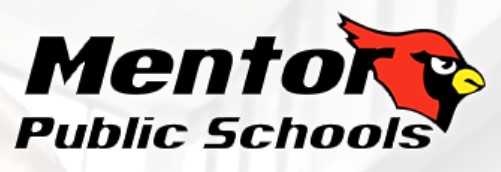
Mentor Public Schools’ presentation explains to teachers how they can become “co-conspirators while using a curriculum rooted in whiteness.”
Incidents
A concerned community member provided Parents Defending Education with a presentation that Mentor Public Schools used in training teachers in the school district. The presentation appears to have been taken from the BetterLesson website. The title of the presentation was “Curriculum for Social Justice: Examining What We Teach and How to Critique it.” A goal of the training session seems to be for teachers to view their jobs through “social and racial justice lenses.”
In explaining the purpose of the presentation, a slide titled “Today’s Sessions” asks the question for teachers: “How can I be a co-conspirator while using a curriculum rooted in whiteness?” The slide also explains that a goal for teachers should be “Becoming Co-conspirators.” The next slide explains that a co-conspirator is “a person whose actions combat racism through direct challenge to or subversion of racist structures and institutions.”
As an example of “educators as co-conspirators,” the presentation links to an article titled “Thirty-one Mission Hill School faculty protest Wit and Wisdom curriculum.” The article features a letter from teachers telling their school that they can’t accept a new curriculum because “of the texts we reviewed, only 39 of 174, or 22%, were written by people of color.” The letter continues to state:
Many of the units, including “Here Come the Redcoats,” “The American West,” and “Narrating the Unknown,” perpetuate harmful dominant narratives of history while excluding marginalized voices and exacerbating systemic injustices that BPS students have been facing for generations.
Teachers continue to state in the letter that “if we are serious about ‘transforming’ schools, decolonizing our texts and curricula must take the forefront.” The presentation shown to teachers at Mentor Public Schools then states: “Keep in mind how these educators used their privilege to advocate for better diversity in their curriculum to reflect the students they teach.” The presentation then follows up the statement on the next slide by asking: “What resonates with you about the article that we just read?”

The presentation then quotes a teacher who works with the organization Learning for Justice. The quote emphasizes that “racist beliefs and structures” are in every aspect of our lives:
Anti-racist work means acknowledging that racist beliefs and structures are pervasive in all aspects of our lives—from education to housing to climate change—and then actively doing work to tear down those beliefs and structures. Those beliefs and structures don’t just exist in primarily white/and or privileged institutions—they thrive there.
Learning for Justice is an organization known for pushing its “Social Justice Standards” to be adopted in schools throughout the country. The document for these standards includes goals to achieve for students. One goal is that “students will develop language and historical and cultural knowledge that affirm and accurately describe their membership in multiple identity groups.” Another goal appears to outright state that the purpose of the “Social Justice Standards” is to turn students into political activists: “Students will make principled decisions about when and how to take a stand against bias and injustice in their everyday lives and will do so despite negative peer or group pressure.”
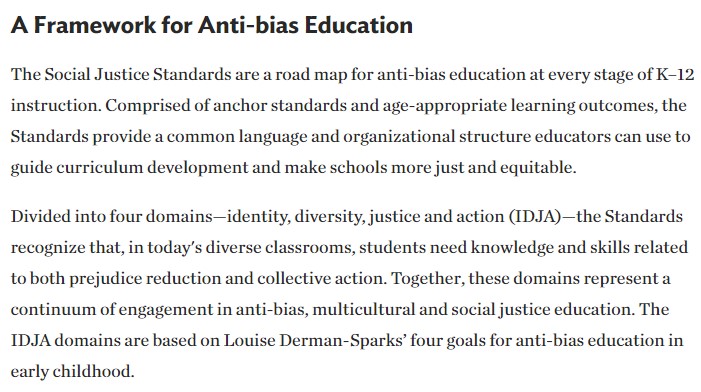
The presentation also features a video titled “Dismantling White Supremacy in Education.” The speaker in the video argues that “white supremacy” is embedded in America’s education system. She explains that “we can’t possibly destroy a system like white supremacy and build something new if we’re using the same tools that created it.” [Time Stamp: 2:40] The presentation then asks teachers: “What resonates with you about the video that we just watched?”
The presentation also features a diagram labeled “Becoming Anti-Racist.” The statements “I deny racism is a problem” and “I strive to be comfortable” are the farthest away from becoming “anti-racist.” Meanwhile, the statements “I sit with my discomfort” and “I identify how I may unknowingly benefit from Racism” are statements closest to becoming “anti-racist.”

The presentation then explains that teachers should re-evaluate the curricula they teach because “it’s important to remember that our education system has been founded on historically racist practices, including silencing those from disenfranchised communities.” Questions are then provided to teachers to ask themselves about their curricula:
- What voices are being amplified? Students from communities with white privilege need to hear voices from other races/ethnicities/cultures in order to grow their own thinking.
- Are the voices of color offering a different perspective or aligning with the traditional narrative? Perspectives need to be diverse and empowering as well—only showing POC suffering or slavery does not begin to break down problematic beliefs about POC.
- How are the dynamics of power depicted? Students coming from positions of power need to see and understand the power and agency of those who have been historically disenfranchised because society frequently tells them otherwise.
- Does the narrative perpetuate “savior” behavior? In understanding our history the narrative can center BIPOC voices while allowing white students and teachers to see examples of themselves as allies and accomplices instead of “saviors.”
The presentation provides ways teachers can evaluate their lesson plans. These include looking for “omission,” “authenticity,” “language,” and “perspective.” The presentation states for “omission” that “exclusion and erasure are some of the most insidious and painful forms of bias.” For “authenticity,” the presentation tells teachers to “check for inaccuracy and inappropriateness in the depiction of cultures and lifestyles.” For “language,” the presentation tells teachers to “consider how certain words have negative connotations or racial bias.” The presentation for “perspective” tells teachers to ask themselves: “Does the lesson consider a situation from several perspectives?”
The next slide of the presentation states that “as an educator using a curriculum rooted in whiteness, being a co-conspirator means”:
- Actively being an agent of change.
- Disrupting racist narratives and systems.
- Being willing to unlearn, in order to relearn.
- Developing awareness and teaching students the same.
- Using an auditing tool to evaluate and challenge content.
The presentation then asks: “How can I be a co-conspirator while using a curriculum rooted in whiteness?” The next slide then promotes using an “auditing tool.” The slide explains that “an auditing tool is a resource that will help you evaluate the content you’re teaching.” The slide then explains that an auditing tool will help “to identify specific strengths and weaknesses within curriculum,” “provide a guide to make changes that redefine whiteness,” and “to create indicators needed to improve teaching and learning.”
The next slide states that while developing an auditing tool, teachers should ensure that the the goal is that “ALL students must feel that their identities are validated and that their school is a place that accepts them completely.” The following slide is titled “How To Audit” and explains that an audit should “scrutinize the curriculum,” “set objectives,” and “collect feedback and data.”
A later slide in the presentation is titled “Scenarios” for teachers to discuss in groups. After reading the scenarios in groups, the presentation asks teachers to “work together to outline questions to scrutinize the curriculum and set objectives.” The following scenarios were provided to teachers:
- Claude’s social studies curriculum still does not include Hispanic Heritage Month. After petitions, a task force that produced a tentative curriculum, and noteworthy stakeholders willing to contribute – his district has omitted it from content again this year. He decides to recognize it on his own! He ends the unit with a potluck for his class to celebrate, students sign up to bring dishes from different countries.
- Pia’s 10th grade English class is required to read Shakespeare in order to demonstrate mastery of a standard. Every year the curriculum provided gives dry lessons that she struggles to deliver and students struggle to comprehend. At the start of this school year families have asked if there are instructional changes she can make to meet the needs of the students.
- Samaad is a first year teacher at the elementary school she attended. She remembers feeling “othered” as one of the few students of color with teachers that did very little to support her. Upon her return she’s surprised to learn that there have been many systemic changes after teachers of color complained about a lack of inclusion. In response, there’s mandatory ongoing PD for staff and a committee was formed to review school and staff culture, curriculum design, & student performance.
- Franz has held various roles in education from teacher to principal and administrator. A close friend is opening a school and in need of content, so he consults Franz. The new curriculum is inclusive of SEL, relevant, & diverse reflections of global citizens. But more expensive and require extensive training. The traditional option is inexpensive, but old and a heavy lift on teachers to adjust to reflect the students.
The presentation then promotes several resources for teachers. These resources includes links to the organizations Learning for Justice and Teaching While White, as well as a document titled “How Race and Racism Empower a School’s Curriculum.” This document outright promotes using education to change the views of Americans. The abstract of the paper states:
Indeed, having constructed, well-thought-out lessons about race and racism “myth-bust” any attempts for future Americans to continually embrace xenophobia and genetic inferiority. In recent years, the institution of education and schooling has shown progress changing young people’s mindsets toward the LGBTQ community, diverse learners, and disabled citizens.
The document continues to state that “the history of America manifested from the concept of race and racism.” The document then states that “racism” is “American as ‘Cherry Pie’ organic to the nation’s heritage, culture, and framework.” The document then explains that “teaching folks about race and racism have to become an intricate part of a school’s curriculum, especially as it pertains to subjects such as history, science, and English.” The discussion of teaching “race and racism” in “math” is discussed next.
The presentation has a later slide titled “Explaining HOW to Critique” that provides steps for teachers to examine and potentially change a curriculum. These steps appear to attack “capitalism” and “Standard English.” The following subjects were provided with steps to critique each one:
- Science
- Examine the effects of capitalism on the environment and biological systems.
- Study environmental racism and its effects at local, national, and international levels.
- Discuss misogyny and racism in STEM fields and how to counter it.
- Highlight the scientific contributions of BIPOC.
- Math
- Have students use statistics, algebra, etc. to analyze the rates and effects of different social problems and injustices in areas such as banking, the criminal justice system, education, housing, etc.
- Use math for a purpose, in context, and not in the abstract (to analyze and discuss social problems).
- ELA (English Language Arts)
- Choose texts that address themes related to systems of oppression and social justice, especially written by BIPOC.
- Bring student voices and experiences into the discussion of texts and allow them to personally relate to the materials and its themes.
- Critically analyze all texts and ask higher order thinking questions to get students thinking about systems of oppression.
- Allow students to research systems of oppression and write about their own experiences or those of people in their lives.
- ESOL (English to Speakers of Other Languages)
- Examine and use English language structures as a means to discuss social issues while bringing student voices and stories into the discussion.
- Examine the oppressive nature behind enforcing “Standard English.”
- Study and affirm the validity of various dialects.
The presentation then provides a link to the organization RadicalMath for teachers. The homepage of the organization states: “RadicalMath empowers educators to address issues of social and racial justice in math classrooms through curriculum, lesson planning resources, and professional development opportunities.” RadicalMath even has a document titled “A Guide for Integrating Issues of Social and Economic Justice in Mathematics Curriculum.” The document outright states that the organization’s goal is to turn students into political activists: “No matter the experiences, advantages, struggles, neighborhood, race, class, and gender of your students, learning math within a social justice framework is important for their understanding of both the math concepts and of their opportunities to be agents of change.”
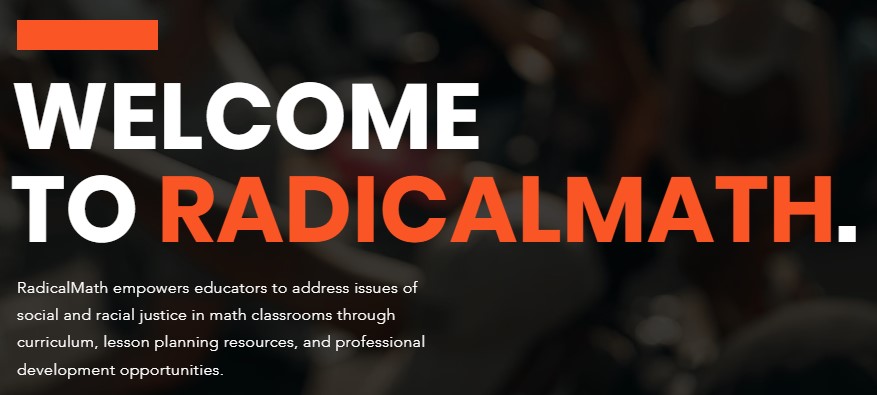
The organization BetterLesson appeared to present the training session. The organization provides services to districts to help them implement “equity” and “inclusion” into their schools. The organization has a “Diversity, Equity, and Inclusion” page on its website that states: “An excellent education for all is the cornerstone of an equitable society. We are committed to supporting educators in creating equitable learning environments that help all students thrive.”
The organization offers resources to teachers called “Culturally Responsive Teaching Strategies” and “Racial Equity Webinar.” One resource is specifically called “Teaching Social Justice in the Primary Classroom.” This resource states: “Implementing the steps outlined in this strategy will help teachers develop lessons that allow students to explore bias and social justice.”


BetterLesson also promotes a document on its website called “The BetterLesson Diversity, Equity, and Inclusion Continuum.” The document states: “Confronting and dismantling systemic racism is a long term process of personal and collective growth. To honor our commitment to anti-bias, anti-racist mindsets, dispositions, and decisions, BetterLesson team members will receive support to grow along a diversity, equity, and inclusion continuum within specific indicators/domains.”
For promoting “personal growth,” the document states that people should work toward “building our awareness of self, others, societal issues, and seeing our potential to contribute to societal change.” For “organizational growth,” the document states that BetterLesson will be “celebrating people of all races, ethnicities, cultures, genders, gender identities, abilities, social classes, ages, and religions with the images we select in our content.”
BetterLesson also has a page on its website labeled “Diversity, Equity, and Inclusion Glossary.” The page states that “language is ever-changing” and that the organization’s “language guide is constantly evolving and represents our current understanding of the most inclusive language around our work in teacher professional development.”
One definition in the glossary is for the term “intersectionality.” BetterLesson describes intersectionality as “exposing one’s multiple identities can help clarify the ways in which a person can simultaneously experience privilege and oppression.” The organization then continues to state that “a woman with black skin in the United States does not experience gender inequalities in exactly the same way as a woman with white skin, nor racial oppression identical to that experienced by a man with black skin.”
BetterLesson also provides a definition for the term “structural racism.” The organization describes structural racism as “the arrangement of institutional, interpersonal, historical, and cultural dynamics in a way that consistently produces advantage for White people and chronic adverse outcomes for people of color.” The organization then continues to explain that structural racism “illuminates that racism exists without the presence of individual actors because it is systemically embedded.”
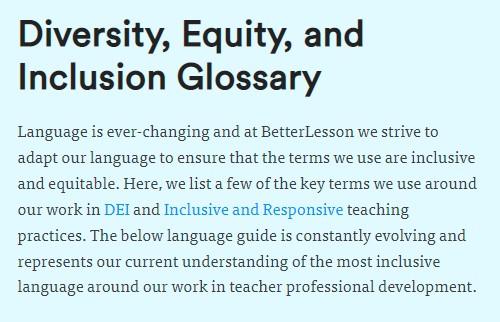


On July 9, 2020, the superintendent of Mentor Public Schools shared a message at the school district’s Board of Education meeting. In this message, the superintendent stated that “George Floyd’s avoidable and tragic death underscores a problem of systemic racism, which still permeates our society.” He continued to state that “while our district has made progress with our work in the areas of diversity, inclusion and equity, we still need to do more and need to do better.”
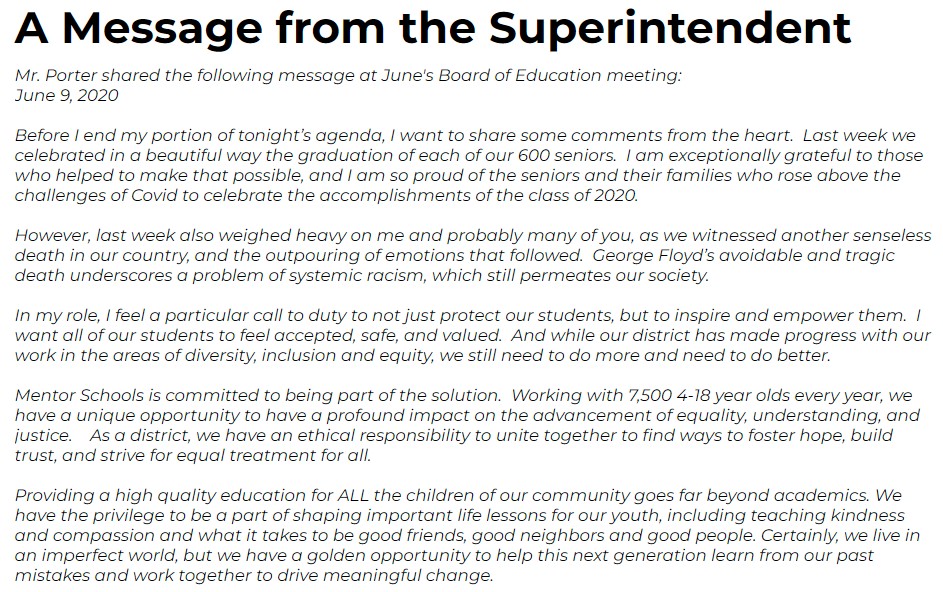
The school district also started a program called “Cardinals Circles” that appear to be what most school districts call “affinity groups.” Affinity groups are segregated groups of staff, parents, or students that separate people by identity attributes such as race and sexual orientation. The school district states that “the program fosters a deeper sense of community throughout Mentor Schools and helps us build a culture of equity, inclusion, and empowerment for our students and their families.” The school district’s website then promotes four of these “Cardinals Circles”:
- Families of Black Students – for parents/guardians of black students in our district.
- Pandemic Parenting – for connection, support, and resources related to the challenges of raising kids through a global pandemic.
- LGBTQ+ Families – for parents/guardians who are LGBTQ+ or have LGBTQ+ students.
- Military Families – for parents/guardians affected by past, present, or upcoming military service.
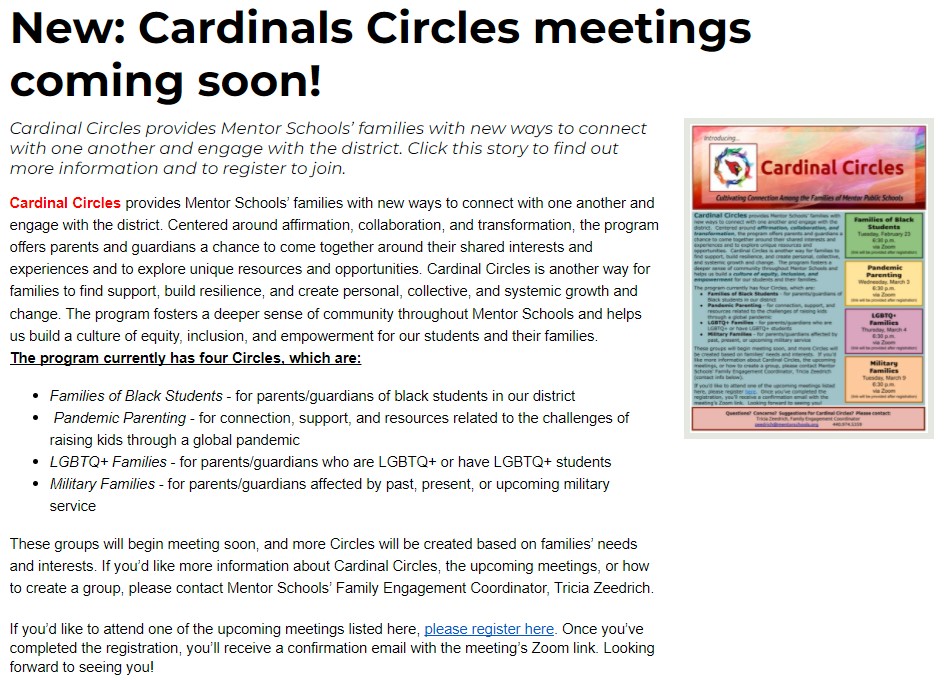
Stay Informed
